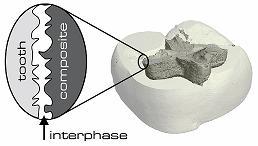Summary
Our goal is to enable the development and manufacturing of biomaterials for oral health moving forward in 21st century by providing critical measurement methods and reference materials. Our multidisciplinary team combines expertise in experimental, theoretical and simulation approaches.
Description

- NIST along with its partners has a long commitment to scientific excellence with demonstrated impact in improving the oral health of the public.
- NIST researchers are leaders in this field and create a community by engaging other researchers, industry, and regulatory agencies to address urgent needs in measurement methods and reference materials that will advance oral health.
- Scientific focus is on the underpinning measurement science to assist the development of robust (repeatable and reproducible) testing methods and reference materials to support oral health.
- Scientific outputs have been and will continue to be transferred to industry through patenting and licensing of technology, and to standards development organizations (e.g., ADA/SCDP, ISO) ultimately affecting clinical practices.
Technical and Programmatic Details:
Photo-cured Polymers, Composites, Adhesives and Coatings
- Curing mode and kinetics, and polymerization stress
- Development of structure-property relationships
- Light efficiency in photo-polymerization
Bacteria – Material Interactions
- Oral biofilm measurements
- Single-cell force spectroscopy for cell adhesion
- Material factors for synergistic interactions
- Antimicrobial substrates and approaches
Biomineralization
- Biomimetic mineralization with polyelectrolytes
- Characterization of mineralizing phenotypes in tissue culture
- Standard Reference Materials (SRM2910b calcium hydroxyapatite, carbonated apatite, biomimetic dentin)
Scaffold-based Bone Regeneration (emerging areas of science in oral health care)
- Polymer/hydroxyapatite (or silicate)-based composite scaffolds for osteogenic potential
- Physical and mechanical properties of composites, and scaffolds
- Biological interactions between dental follicle cells and composites, and scaffolds
History and Partners:
NIST's involvement in dental materials dates back to 1919. In 1928, the Paffenbarger Research Center (PRC) of the American Dental Association Foundation (ADAF) began working at NIST (then National Bureau of Standards, NBS) with the purpose of developing science-based standards for dentistry. The unique collaboration between NIST and PRC has afforded the dental profession the ability to participate in the development of science-based standards and new technologies that are relevant to the needs of the profession. Scientists at NIST and PRC have changed the profession of dentistry in fundamental ways through scientific advancements and discovery. Throughout its history as the PRC, and now with its new name, the Dr. Anthony Volpe Research Center (VRC) has been at the forefront of dental materials research. Today, scientists continue the tradition of transferring scientific advances from the bench to the clinic.
Much of this collaborative research has been funded by the National Institute of Dental and Craniofacial Research (NIDCR/NIH). NIST and NIDCR have had an interagency agreement since the 1960s to advance materials and measurement methods for improving oral health. Together, scientists at NIST and PRC, with the support of NIDCR, have developed numerous new technologies and established many scientifically based standards for dental materials, instruments, and therapies.
Today NIST continues its close working relationships with NIDCR and the ADAF, while also establishing closer ties with the Food and Drug Administration (FDA). The NIST dental research team is also actively involved in the consensus standards bodies (e.g., ADA/SCDP, ISO TC 106), while working closely with dental industry and academic research laboratories.

